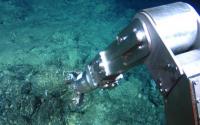Revision of U.S. has significant economic interests in emerging deep seabed mining industry from Thu, 05/29/2014 - 14:12
Quicktabs: Arguments
Lockheed Martin has already sent American jobs outside the U.S. in order to obtain the benefits from ISA Member States.232 As 2018 approaches, the eyes of the world will turn its focus on Nautilus’ attempt to successfully operate the world’s first deep seabed mining operation.233 The success of the Solwara 1 Project will usher in a new era of opportunity for all, excluding non-ratifying States like the U.S.234 The probable response by other U.S. companies would be to follow Lockheed Martin’s footsteps, triggering the trend of utilizing foreign subsidiaries to operate deep seabed mining businesses, to the detriment of the United States.235
Likewise, with $100-a-barrel oil prices and nearly one-third of all the world’s hydrocarbons being produced off-shore, it would be folly for the U.S. to ignore the need for access to extended outer continental shelf (OCS) oil and gas resources. The great irony of the U.S. debates over the Law of the Sea Convention is that for years (since the Reagan Administration rejected the treaty in the early 1980s) we have been focusing on the wrong seabed resources. Although the original UNCLOS was rightly rejected because of its absurdly drafted provisions on the mining of manganese nodules (including the creation of an international mining consortium, known grandiloquently as “The Enterprise”), UNCLOS has relatively fewer provisions on such ocean resource activities as lifting oil and gas reserves beyond 200 nautical miles, mining polymetallic sulfides and other exotic substances found at mid-ocean ridges, bio-prospecting the unique flora and fauna of the ocean abyss, and salvaging historic shipwrecks.13 That the United States might extend its Arctic continental shelf off Alaska as far out as 350 nautical miles has the oil industry – and Alaska’s Senate delegation – salivating at the possibilities. But that extension would only be possible if the U.S. accedes to UNCLOS and files a claim before the U.N. Commission on the Limits of the Continental Shelf.14
Now what was at stake for the United States in this? At stake was access to these mineral resources, these huge mine sites that are equivalent to the largest in the world today. The aggregate value of the minerals in the mine sites we are going to lose if we do not move forward on this treaty, may be—hold on to your hats—one trillion dollars.19 Now just to put that into perspective, the total cost so far of the Iraq War is debated as being somewhere between a quarter of a trillion and three-quarters of a trillion dollars.20 This large amount, a trillion dollars may be at stake in access to critical minerals for the United States of America in going forward with this treaty.
Our economy is hurt when delimitation of our extended continental shelf is delayed and when legal uncertainties from non-membership prevent our oil and gas industry from exploiting the rich continental margin, especially in the Arctic. Development of resources in the Chukchi and Beaufort Seas off Alaska's coast would create approximately 54,700 jobs per year nationwide with a $145 billion payroll and would generate $193 billion in federal, state and local revenue according to a study done by the University of Alaska's Institute of Social and Economic Research.
The delay in ratifying this treaty has already cost the loss of one of our four seabed mine sites, the richest in the world, and if we do not soon adhere the United States risks losing the remaining three, with billions in the strategic minerals manganese, copper, cobalt and nickel at stake. A single seabed mining operation would spur the economy with total capital purchases of close to one and a half billion dollars and would stimulate robust job creation. Further, for our nation to lose this new industry would cost millions in consumer losses and foregone tax revenues and billions in our balance of trade as the United States was forced to import rather than produce these strategic minerals.
Undersea cables carry more than 95% of international Internet and telephonic transmissions. These crucial cables also transmit financial data and transactions worth trillions every day. The Convention establishes the legal underpinning for protecting and managing these cables. At a National Press Club event a spokesman for AT&T warned that not being a party places America's crucial communication links at risk.
Coral reefs, mangroves, and estuaries are now considered "among the most highly diverse, integrated and productive of the earth's ecosystems."19 An estimated 175 billion dry metric tons of minable manganese nodules, containing as many as 30 elements, including manganese, nickel, copper, and cobalt, cover about 15 percent of the deep seabed.20 If correct, these reserves far exceed known land deposits.21 Yet initial estimates tended to overestimate not the mineral wealth, nor necessarily the ability of technology to mine it, but the economic feasibility of such endeavors. Mining engineer John Mero predicted in 1965 that by 1985 operations would be processing 50 million tons of nodules annually.22 However, those corporations that had seabed mining technology also had substantial invested interest in the continuing profitability of land-based minerals. Thus, mining of the seabed has not yet become a growth industry. Nevertheless, this vast potential wealth, located on the 70 percent of the earth's surface covered by the oceans,23 is the impetus for both the attempt to privatize the ocean and the resistance to such an enclosure.

As the future of seafloor mining is debated this week, here are five things you need to know about the risks and rewards of extracting precious metals and minerals from the ocean.
[ More ]